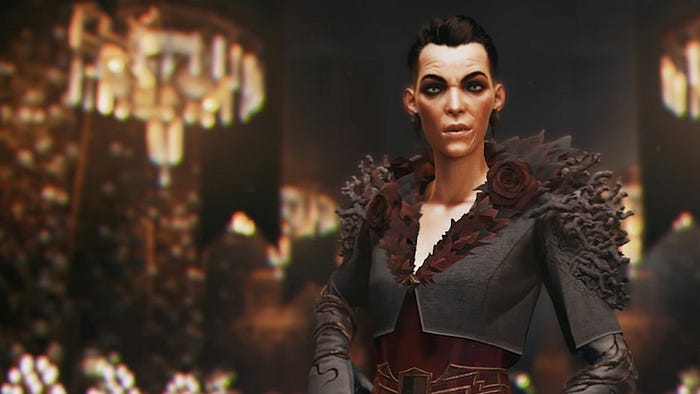Dissecting Dishonored — Part 3: Dishonored 2 Is A Worse Version Of The Dishonored DLCs

In the last part, I went into detail about why Emily’s Low Chaos arc failed, and why her High Chaos arc works in a perverse way because of this. In this piece, I’m going to compare Dishonored 2 to the two-part story DLCs of Dishonored, The Knife of Dunwall and The Brigmore Witches. I argue that Dishonored 2 has as much in common with these DLCs as they do with the first game, if not more, and unlike the comparisons with the first game, Dishonored 2 doesn’t measure up to the DLCs as well.
A Recap of the DLCs

The Dishonored DLCs are arguably the peak of the Dishonored series, many people (myself included) hold this opinion. The DLCs deviated from the base game in a few significant ways: you play as an already established character, Daud who assassinated the Empress, Daud is a voiced protagonist and unlike Corvo, he has a clearly defined character arc. Corvo as a character undergoes a transformation through his story too, but the absence of dialogue from him means that it’s largely left to the players to interpret Corvo’s feelings about the game’s events as well as his motivations for the action he performs.
The Knife of Dunwall opens with a monologue from Daud, expressing concern that the Empress’ murder wasn’t just another job, and is implied to feel some guilt over the current state of the city. The game then takes us to a recreation of the Empress’ murder in the Void, where the Outsider gives Daud a final chance to ‘make his own ending’, giving him the gift of a name — Delilah. The majority of the two DLCs centers around Daud’s efforts to track down Delilah, bring him closer and closer to understanding her motivations and confronting her in Brigmore Manor, a sprawling, aesthetically-pleasing decrepit estate outside the city.
There are twists and turns along the way: a growing number of Daud’s Whalers believe he has lost his edge, this culminates in Billie Lurk, his right hand, betraying him for Delilah against the backdrop of a surprise Overseer invasion of Daud’s territory. Daud learns that Delilah has been similarly gifted by the Outsider, and can even talk to her through one of her sculptures in the second mission of the game. The level also provides a hint as to Delilah’s larger plans, in the form of a creepy poem about Emily being possessed.
Daud never really confronts Delilah in the conventional sense; there is no speechifying by either side. Instead, Daud uncovers Delilah’s ritual and either sabotages it, trapping her in the Void or simply killing her after a brief fight. Dishonored 2 states that the former is the canonical ending. After Delilah is dealt with, Corvo and Daud have their confrontation as they do in the base game, but this time, we see it through Daud’s eyes. Daud makes the same speech as he does in the base game, and if the game was in Low Chaos, Daud is spared, after which he leaves his life in Dunwall behind, while in High Chaos, Daud is flung off the side of the building.
Hey There Delilah, What’s It Like In Dunwall City? (I had to make this joke at least once)

As I mentioned in the first part, Dishonored 2 functions more as a sequel to the DLCs than to the base game. It deals with the consequences of the ending of the DLCs, has more returning characters from the DLCs than the base game and continues with conventions introduced in the DLCs like voiced protagonists and an introductory monologue for the game and each level. These are similarities that make Dishonored 2 a sequel to the DLCs, but not what makes it a retread.
The biggest reason that Dishonored 2 is a retread of the DLCs is that the both feature the same villain. A series having an overarching villain isn’t by any means a bad thing. But in order to reintroduce Delilah, the game had to undo the ending of the ending of the DLC (and unfortunately this is not the last time the series would overwrite the ending of The Brigmore Witches). Like the first game, one of Delilah’s motivations was to become Empress, but now they extend beyond just that.
To the game’s credit, it does give thought to what Delilah did in the Void. She has corrupted it, and stolen some of the Outsider’s power, becoming a part of him and the Void. She can’t be killed by ordinary means anymore. But to me, it feels like a sequel compelled to have a large scope than its predecessor simply because it’s a sequel. Her grand plan this time around is to use a magic painting to reshape reality to her will. To me, this is essentially a massively scaled-up version of her attempted possession of Emily. The possession of a world of Emilys, if you will. It’s especially egregious since her method for achieving this goal is exactly the same as the last time around, i.e. an enchanted painting. The Low Chaos route for neutralizing her, trapping her in the painting, is exactly the same as the last time around too, except that now, canonically she has escaped from this fate once, and the player has no reason to believe that this time is any different.
Emily And Daud — Two Sides Of The Same Coin

Emily’s story throughout Dishonored 2 parallels Daud’s story in the DLC in a number of ways. Emily’s arc is a Lighter And Softer version of Daud’s arc, just like Dishonored 2 is one for the first game. Daud begins the game feeling regretful about the assassination of the Empress, and based on some of the Outsider’s dialogue, has been at least a little bitter about the way he’s used his powers. Jessamine’s assassination puts him at a crossroads, and the Outsider gives him some direction on where to go. In the Low Chaos route, Daud decides that it’s time for a change, and to put this way of life behind him. He rescues the daughter of the woman he murdered, securing an Empress, without anyone knowing, and finally makes peace with who he is. In High Chaos, he silences the growing doubts in his mind by committing tenfold to the violence, striking down Delilah because she was put in his way, and then dies at the hands of Corvo, engineering the encounter, and not really expecting it to go any other way.
Emily by contrast starts her story bored with and stifled by her responsibilities. Delilah’s usurpation puts her at a similar crossroads. In Low Chaos, she learns to take her duties seriously and that ruling is not something she is entitled to but must earn. In High Chaos, she gets her chance to take revenge on the subjects she resents, finds that she likes it, and believes that to rule is to show no mercy for any reason. Except that, as I discussed in the last piece, her Low Chaos route feels hollow since she never truly holds herself accountable and her words aren’t backed up by her actions.
In contrast to this, in the DLCs, the first thing the player hears from Daud is remorse for killing the Empress. The Outsider regularly reproaches Daud for the decisions he’s made through his life that mince no words, and carry weight in a way that Sokolov and Billie Lurk’s blink-and-you’ll-miss-it rebukes feel hollow. Daud never outright says that he wants to change, but in Low Chaos, his commitment to finding different ways to achieve his goals, coupled with NPC comments remarking on this change, or mocking him for losing his edge/attempting the futile are convincing of his new attitude. Emily in Dishonored 2 never gets a chance to demonstrate with actions that she’s committed to helping people. Nor does anyone comment on any change in her.
The way the game ends is also revealing of this parallel. The game is aware that Daud has done too much evil to ever be redeemed and so it sets its sights lower. The game’s endpoint is Daud making peace with himself. He will never be able to fix killing Jessamine, but he was able to stop things from getting even worse, by saving Emily, and in Low Chaos, he did it without spilling too much blood. Emily’s misdeeds as they were, are much more forgivable, and yet, by never having Emily outright recognize that she wasn’t doing her best in the beginning, the game’s Low Chaos conclusion feels hollow and insincere. The game created a less bleak environment and a less dark character, but didn’t seem to do anything with either of these things.
A Note On Chaos Routes
A final point of contrast between the two characters is that in my opinion, just as Emily’s Low Chaos run feels hollow compared to Daud’s, Daud’s High Chaos run feels weaker compared to Emily’s. I’ve already talked about why Emily’s High Chaos run works. In essence, her motivations for butchering everyone in her way feel believable, and her affirmations that violence is the best way to achieve her goals are demonstrated by her actions in the game. High Chaos Daud is a different beast. While it is believable that he would resort to even more murder to silence the doubts in his mind (the achievement for completing the DLCs in High Chaos is called ‘No Regrets’), the ending monologue, which is the same for both runs, doesn’t make as much sense here. I find it difficult to believe that High Chaos Daud, who responds to feelings of guilt over killing, by doing even more killing, would care about saving Emily.
But this is just a point of contrast, not yet another way that Dishonored 2 is bad, right? In the last part, I said that it doesn’t bother me that Emily’s High Chaos route is a better fit for her than Low Chaos, but that I could see people being upset about that. I think the developers fall in that category too, given that so far, Corvo and Daud have canonically had Low Chaos runs, and there’s nothing from them indicating that Emily would be any different. The point I’m trying to make here is even more tenuous than these other points, but I do think that if you intend for the playable characters to take the morally good route, but the morally bad route works better, then, it is an example of a misstep or a series of missteps in characterization and options in the gameplay. Or maybe it’s just that characters breaking away from their previously defined positions to do the opposite of what you’d expect them to do is more appealing to me.
Conclusion
The Knife of Dunwall and The Brigmore Witches was always going to be a tough act to follow. But by reusing the same villain, who has a scaled-up version of the same evil masterplan, and is accomplishing it the same way as the last time, and is dealt with in the same way as the last time, Dishonored 2 does a disservice to both itself and the DLCs. Emily’s character arc is an echo of Daud’s but lacks the weight of the latter. Dishonored 2 has as much in common with the DLCs and indeed a stronger sequential tie to it than to the base game, but unlike the subversive relationship it has with the first game, the empty reprisals of the DLCs here, do Dishonored 2 no favours.
In the next part, I wrap up this series by going over some of the other problems I think Dishonored 2 has, both big and small, that hold it back from being a truly great game.
